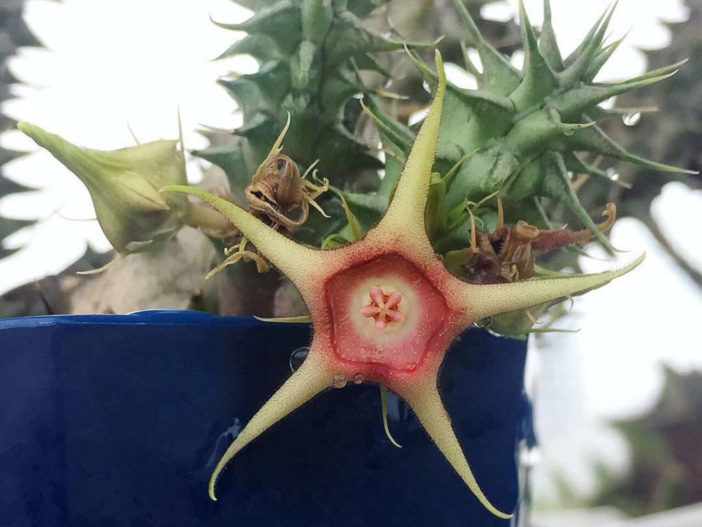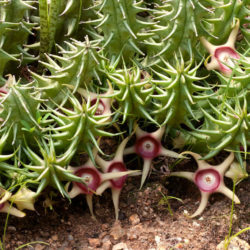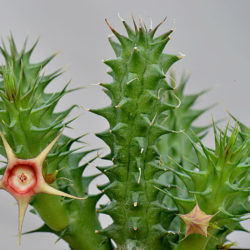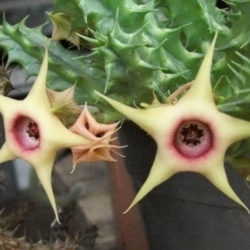Scientific Name
Huernia verekeri Stent
Synonym(s)
Ceropegia verekeri, Huernia verekeri var. verekeri
Scientific Classification
Family: Apocynaceae
Subfamily: Asclepiadoideae
Tribe: Stapeliae
Genus: Huernia
Description
Huernia verekeri is a small succulent with fleshy, green to purplish-green stems with long, pointed tubercles joined in 5 to 7 angles along the stem. The stems are erect, decumbent, or ascending and can grow up to 4 inches (10 cm) long, branching from the base and forming a diffuse clump.
The plant produces 1 to 5 flowers on thick, up to 0.4 inches (1 cm) long stalks near the base of the stems. The flowers are star-shaped with five narrow, tapering lobes and can reach up to 1.8 inches (4.5 cm) in diameter. They open in succession. The corolla is cream with a pinkish-purple ring around the edge of the broad, shallow mouth of the tube, turning white towards the base. Tiny purple hairs are often on the corolla outside the mouth, and some purple coloring inside the mouth, mainly near the rim. The corona has ivory to creamy white outer lobes and five club-shaped, cream inner lobes with a maroon hue.
Origin
Huernia verekeri is native to Namibia, Botswana, Zambia, Zimbabwe, Malawi, and Mozambique. It grows in stony places under trees or shrubs in woodland.
Etymology
The specific epithet "verekeri (ver-EK-er-ee)" honors Louis Stanhope Amos Vereker (1874-1948), a Rhodesian farmer who collected the type specimen.

Hardiness
USDA hardiness zone 10b to 11b: from 35 °F (+1.7 °C) to 50 °F (+10 °C).
How to Grow and Care
Huernias require a potting mix with excellent drainage. A succulent plant mix of 50 percent pumice or perlite, 25 percent peat or organic mulch, and 25 percent sand helps prevent rotting and overwatering. Roots experience dieback in cool-season dormancy, so plants grow best in shallow containers, allowing the soil to dry out quickly. Using clay pots further helps the soil from staying too wet. An underlayment of coarse gravel below the soil mix also improves drainage. In climates with damp, cool summers, a layer of gravel between the plant and the soil mix also helps prevent the stems from staying too moist.
Outdoor plantings do well in raised beds. Huernias prefer bright light or partial shade. In nature, they grow underneath shrubs or other plants. Too much sun causes stems to develop protective reddish or purple pigmentation and can scald the stems. Too little light leads to weak, thin growth with decreased flower production. Huernias grow best between 50 and 80 °F (10 and 27 °C). Protect them from freezing weather.
See more at How to Grow and Care for Huernia.
Links
- Back to genus Huernia
- Succupedia: Browse succulents by Scientific Name, Common Name, Genus, Family, USDA Hardiness Zone, Origin, or cacti by Genus
Photo Gallery
Click on a photo to see a larger version.


